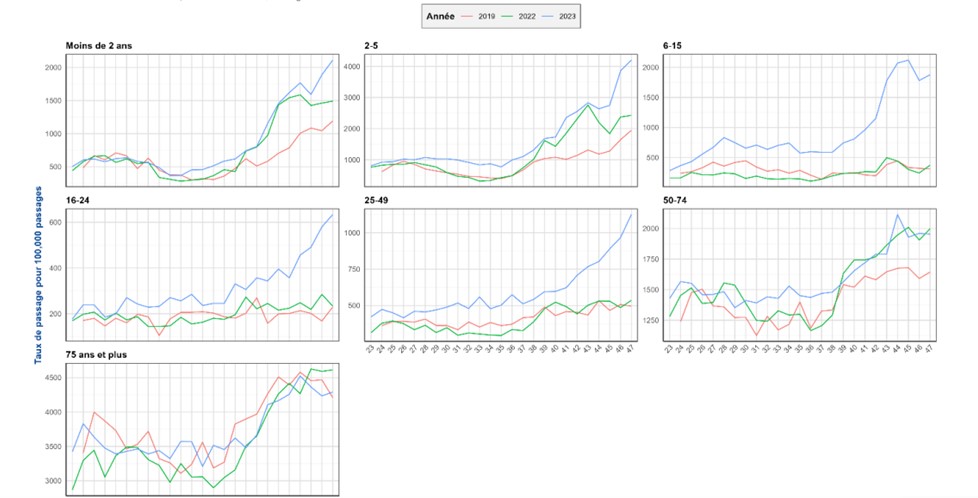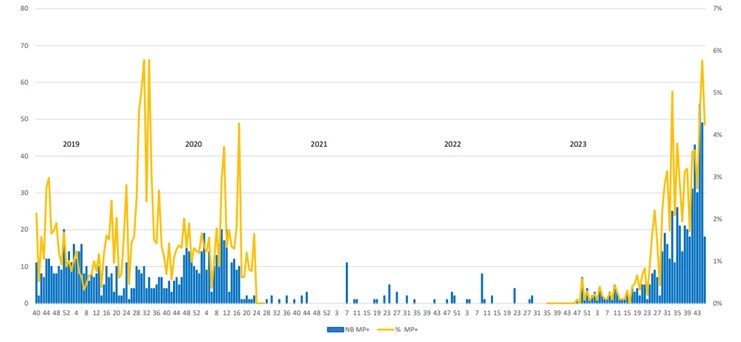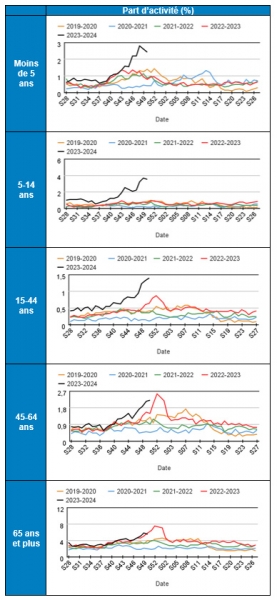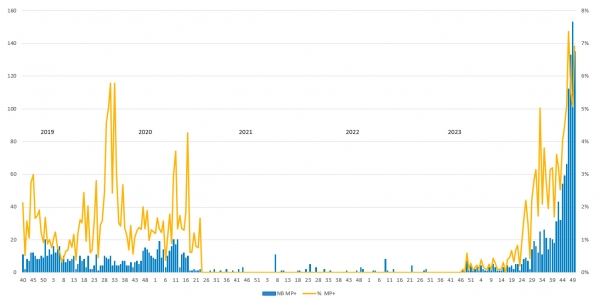Translation Google
“An unusual increase” in cases of Mycoplasma pneumoniae: the worrying alert from the Directorate General of Health
Health
Published on11/29/2023 at 1:01 p.m. , update at 1:22 p.m.
MANON LOZANO
This Wednesday, November 29, 2023, in a message sent to health professionals, the General Directorate of Health (DGS) alerted of an “unusual increase” in cases of respiratory infections due to Mycoplasma pneumoniae. Several “cases requiring hospitalization among adults and children in France” have also been identified.
Last Wednesday, the WHO was concerned about an increase in respiratory diseases in China. The country assured that it was not the emergence of a new pathogen but an increase in cases of influenza, RSV and, more particularly, mycoplasma pneumoniae. This is a bacteria discovered in 1944, responsible for acute respiratory infections.
This Wednesday, November 29, the General Directorate of Health (DGS) alerted health professionals of an “unusual resurgence” of cases of respiratory infections caused by Mycoplasma pneumoniae, “including cases requiring hospitalization in adults and children. children in France", reports BFMTV .
Consultations for pneumonia up 36% among those under 15 years old
This “atypical” bacteria has been closely monitored since SOS Médecins reported an increase in lung infections among children at the end of November, particularly among those aged 6 to 15. From November 13 to 19, consultations for pneumonia increased by 36% among those under 15 years old. Visits to emergency rooms for the same cause increased by 28%, still among children under 15 years old. Sudden increases, without comparison with the number of cases in previous years, during the same period.
According to this same document, Mycoplasma pneumoniae is responsible for respiratory infections, very common in children over 4 years old and young adults, the vast majority of which are benign and heal spontaneously. “Human-to-human transmission occurs via droplets and incubation is 1 to 3 weeks,” we further learn.
Should we be worried?
Infectious diseases are not very contagious and epidemics are quite rare. These come back every 4 to 7 years. “ The cyclical nature of epidemics is favored by the loss of immunity over time after an infection and the existence of different genotypes of M. pneumoniae circulating in the population”, notes in a document published in 2019, the French Society of microbiology.
The infection first manifests itself as tracheobronchitis, a dragging cough. The evolution is slow and favorable. But this can be complicated by "a picture of primary atypical pneumonia, often progressive in onset, with a febrile syndrome, signs of the ENT sphere and a dry cough", specifies the French Society of Microbiology. Which adds that the bacteria “even comes first in community-acquired pneumonia in children requiring hospitalization”. The diagnosis is confirmed by carrying out a PCR test in the laboratory. Treatment consists of taking antibiotics such as roxithromycin, azithormycin or clarithromycin.
If viral symptoms persist in a child, it is advisable to consult a doctor.
“An unusual increase” in cases of Mycoplasma pneumoniae: the worrying alert from the Directorate General of Health
Health
Published on11/29/2023 at 1:01 p.m. , update at 1:22 p.m.
MANON LOZANO
This Wednesday, November 29, 2023, in a message sent to health professionals, the General Directorate of Health (DGS) alerted of an “unusual increase” in cases of respiratory infections due to Mycoplasma pneumoniae. Several “cases requiring hospitalization among adults and children in France” have also been identified.
Last Wednesday, the WHO was concerned about an increase in respiratory diseases in China. The country assured that it was not the emergence of a new pathogen but an increase in cases of influenza, RSV and, more particularly, mycoplasma pneumoniae. This is a bacteria discovered in 1944, responsible for acute respiratory infections.
This Wednesday, November 29, the General Directorate of Health (DGS) alerted health professionals of an “unusual resurgence” of cases of respiratory infections caused by Mycoplasma pneumoniae, “including cases requiring hospitalization in adults and children. children in France", reports BFMTV .
Consultations for pneumonia up 36% among those under 15 years old
This “atypical” bacteria has been closely monitored since SOS Médecins reported an increase in lung infections among children at the end of November, particularly among those aged 6 to 15. From November 13 to 19, consultations for pneumonia increased by 36% among those under 15 years old. Visits to emergency rooms for the same cause increased by 28%, still among children under 15 years old. Sudden increases, without comparison with the number of cases in previous years, during the same period.
According to this same document, Mycoplasma pneumoniae is responsible for respiratory infections, very common in children over 4 years old and young adults, the vast majority of which are benign and heal spontaneously. “Human-to-human transmission occurs via droplets and incubation is 1 to 3 weeks,” we further learn.
Should we be worried?
Infectious diseases are not very contagious and epidemics are quite rare. These come back every 4 to 7 years. “ The cyclical nature of epidemics is favored by the loss of immunity over time after an infection and the existence of different genotypes of M. pneumoniae circulating in the population”, notes in a document published in 2019, the French Society of microbiology.
The infection first manifests itself as tracheobronchitis, a dragging cough. The evolution is slow and favorable. But this can be complicated by "a picture of primary atypical pneumonia, often progressive in onset, with a febrile syndrome, signs of the ENT sphere and a dry cough", specifies the French Society of Microbiology. Which adds that the bacteria “even comes first in community-acquired pneumonia in children requiring hospitalization”. The diagnosis is confirmed by carrying out a PCR test in the laboratory. Treatment consists of taking antibiotics such as roxithromycin, azithormycin or clarithromycin.
If viral symptoms persist in a child, it is advisable to consult a doctor.









Comment